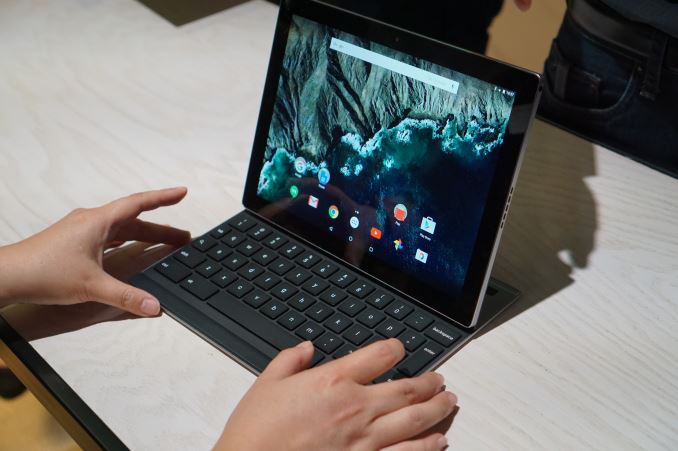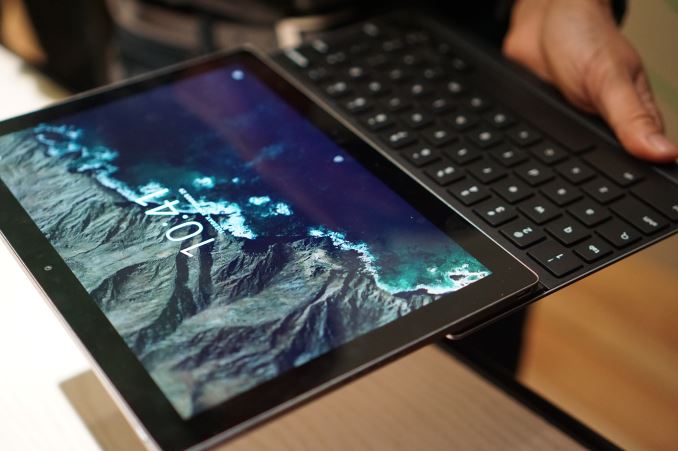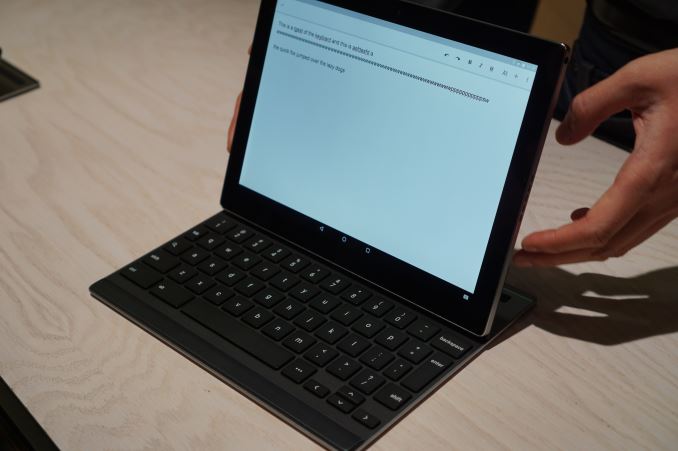Google Announces The Pixel C Tablet
by Brandon Chester on September 29, 2015 6:45 PM EST
In addition to the new Chromecast devices and new Nexus phones, Google gave the world a sneak preview of a new Android tablet which they call the Pixel C. Like the Chromebook Pixel, the Pixel C is designed completely in-house by Google, and it shares many attributes with the Chromebook Pixel even though it runs Android rather than Chrome OS. The hardware is also very interesting, and while there are many unknown details about the Pixel C, what is known looks promising.
As far as specifications go, the Pixel C has a 10.2" IPS display with a resolution of 2560x1800, which equates to a pixel density of 308ppi. Google states that the tablet's aspect ratio is the square root of two, and that's pretty much accurate as 2560/1800 is around 1.42. Representatives at the event stated that the display uses an LTPS backplane rather than an a-Si one, which allows for higher brightness and greater efficiency. Manufacturing LTPS displays at this size costs a considerable amount and it seems that Google felt it was necessary in order to achieve their 500 nit brightness.
As for color, Google advertises that the display covers the sRGB color gamut. I stated this in my live blog, but it's worth repeating that gamut coverage is only loosely correlated with color accuracy. The 2015 Chromebook Pixel covers the sRGB gamut, but is significantly less accurate than a laptop like the MacBook or the QHD+ XPS 13. Based on what I saw at the event, Google has put effort into making sure their new Nexus devices are well calibrated. However, they've also shown lacking effort in doing the same for their $1000 Pixel-branded laptop. I'm very interested to see how accurate the Pixel C's display is, and I'm hopeful that it can stand alongside the new Nexus smartphones and the Nexus 9 when color accuracy is considered.
Inside the Pixel C is NVIDIA's Tegra X1 SoC. Built on TSMC's 20nm process, the X1 packs a quartet of ARM Cortex A57 cores backed by 2MB of L2 cache, and another four A53 cores backed by 512KB of L2 cache, with NVIDIA balancing between performance and power efficiency. Meanwhile the GPU is a 256 core Maxwell implementation that should more than give other Android tablet SoCs more than a run for their money judging from what we've seen in other X1 devices.
It's hard to guess what we're dealing with in terms of clock speeds and TDP, as this is the first time that X1 has shown up in a mobile device. Ryan and Josh have done some previous analysis of X1, and so far the X1 has only been used in the SHIELD Android TV review, an Android TV console built to service 4K video playback and 1080p(ish) native gaming. Compared to the set-top Android TV, performance will obviously differ in a power and thermally constrained situation like a tablet - though by how much remains to be seen - and in any case the X1 remains as one of the most powerful Android tablet SoCs on the market at this time.
While launching the first Tegra X1 mobile device is quite a big announcement, the focus of the Pixel C is actually on the keyboard accessory that you can purchase for it. For Google, the Pixel line has always had a focus on providing users with great build quality, great keyboards, and great trackpads. The Pixel C is no exception, as it has a new bluetooth keyboard accessory designed to work specifically with it. While Apple and Microsoft have opted for soft keyboard covers, Google has decided to make their keyboard accessory out of the same aluminum as the tablet's chassis. This means that there really aren't any compromises as far as key feeling, size, and travel distance are concerned. The keyboard really looks and feels like a slightly condensed version of the Chromebook Pixel's keyboard, with only the lesser used keys around the edges being less than full size.
Almost as important as the keyboard itself is how it works with the tablet. Some devices use a kickstand, while others use the cover itself for support by folding. Google decided to come up with their own way, and when you see it in person you can't help but admire its elegance. The keyboard cover attaches to the tablet magnetically. You can store it on the front to make it like a folded laptop, or on the back when you just want to hide it. When it's on the back you can simply pull the tablet to one side, which shifts the magnetic connection and allows you to elevate the tablet and use it just like a laptop. It's really difficult to describe, but it works incredibly well and allows for a tilt range from 100 to 130 degrees without any sort of kickstand.
Since the keyboard connects via Bluetooth, it does need to be recharged. However, Google has come up with a method of doing so that is as elegant as the keyboard itself. While it's attached to the face of the tablet the small internal keyboard battery is charged inductively by the tablet itself. Having it in that position for only a few minutes a day allows it to stay charged perpetually, and the battery will last up to two months on a single charge. It's just a really ingenious solution and I'm really impressed by it.
The Pixel C is the next device in an emerging category of tablets that sit between your traditional tablet and traditional laptop. How users will respond is anyone's guess, but the Pixel C isn't priced at the extreme high end of the market like Chromebook Pixel is so it should be more accessible to consumers. On the subject of price, the Pixel C will start at $499 for 32GB, and $599 for 64GB, with the keyboard being a $149 accessory.



















58 Comments
View All Comments
Spectrophobic - Tuesday, September 29, 2015 - link
Other than the first mobile Tegra X1, I don't get this product.digiguy - Tuesday, September 29, 2015 - link
it's probably Google's reply to Apple ipad pro, but it lacks the screen real estate for multitasking or even just for using it as A4 size document viewer. It also lacks a stylus (and even on android a stylus can be very handy, like the one in my Note 8) for drawing and annotating. At this price I mainly see it good for gaming on Android (a Nvidia Shield 2 with X1 is rumored to be released soon).MonkeyPaw - Tuesday, September 29, 2015 - link
The iPad Pro was just announced, and before that was just a rumor. Google would not have been able to produce this in less than a month in response. Honestly, this and IPP seem to be a response to Surface. Maybe not because Surface is so popular, but because it is an untapped market with growth potential.Alexvrb - Tuesday, September 29, 2015 - link
Surface 3 (which has been around since what, April?) doesn't have as nice of a display, but it beats the stuffing out of this thing in terms of storage and SoC, and the keyboard cover is $20 cheaper too. Given those two options I'd get the Surface. If I'm actually missing any apps (I can't think of any must-haves that are Android only for me, which are not available as either an app or a win32 program) I could run BlueStacks.I'm really not sure what they're aiming this at. Preempt the next iPad Air?
BMNify - Thursday, October 1, 2015 - link
@Alexvrb: Agree with all your points except Surface 3 display not being nice part, Surface 3 display is excellent and it has been tested by Displaymate and came out as one of the best displays ever put in a tablet, here are the Displaymate quotes:"That is particularly interesting about the Surface 3 is that its display performance is almost identical to the excellent Surface Pro 3 display, including a full sRGB Color Gamut. But in addition, it has a bonus – the Surface 3 is the first display that has a Color Gamut optimized for typical 300 lux indoor ambient light levels instead of for the dark, like all other current displays. It provides the best absolute color accuracy on a display for real-world indoor ambient lighting levels of 300 lux, an important performance feature that no other display currently provides."
"Based on our extensive lab tests and measurements, the Surface 3 has one of the very best and most accurate displays available on any mobile platform and OS. It joins near the top of a small set of Tablets that have excellent top tier displays"
nikon133 - Thursday, October 1, 2015 - link
I'd think OP was referring to "sub-retina" resolution, albeit I'd agree that Surface 3 resolution is still plenty for that size.Thanks for the quote, though - I wasn't aware of that.
Alexvrb - Thursday, October 1, 2015 - link
I didn't say the Surface 3 display was not nice. I said it wasn't AS nice. Sorry, I should have been more clear. I know the Surface 3 display is great. I also know there's more to a display than PPI, especially (as you pointed out) on such a small display. Color accuracy in particular is very important. But I'm sure that at the end of the day the Pixel C will have a slightly better display.I think we can agree that the Surface 3 has a display that's very likely to be pretty close in overall performance (not just raw PPI), and beats the Pixel C in most other regards, despite already having been on the market for some time.
damianrobertjones - Saturday, October 3, 2015 - link
After everything that was said you came back with, "But I'm sure that at the end of the day the Pixel C will have a slightly better display."Probably not.
htcfan - Tuesday, October 27, 2015 - link
As far as the Surface 3 atom processor beating the stuffing out of a Tegra X1 soc. Think again. The X1 is 1 teraflops which the XBox One is 1.3 teraflops. The Surface 3 atom processor is no where near that. It's in the megaflops category.lucam - Wednesday, September 30, 2015 - link
It was rumour for ''normal'' people...people from industry always know the coming products. Google knew about Ipad Pro, likewise Apple for this product.